| |||||
| Decades: | |||||
|---|---|---|---|---|---|
| See also: | |||||
| 1814 in the United States |
| 1814 in U.S. states |
|---|
| States |
| Washington, D.C. |
| List of years in the United States |
Events from the year 1814 in the United States.
| |||||
| Decades: | |||||
|---|---|---|---|---|---|
| See also: | |||||
| 1814 in the United States |
| 1814 in U.S. states |
|---|
| States |
| Washington, D.C. |
| List of years in the United States |
Events from the year 1814 in the United States.

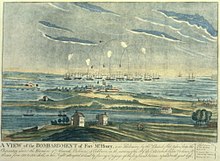
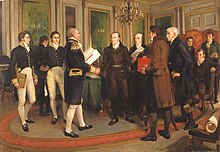
| | This section needs expansion. You can help by adding to it. (November 2011) |

The War of 1812 was fought by the United States and its indigenous allies against the United Kingdom and its own indigenous allies in British North America, with limited participation by Spain in Florida. It began when the United States declared war on 18 June 1812. Although peace terms were agreed upon in the December 1814 Treaty of Ghent, the war did not officially end until the peace treaty was ratified by Congress on 17 February 1815.

1814 (MDCCCXIV) was a common year starting on Saturday of the Gregorian calendar and a common year starting on Thursday of the Julian calendar, the 1814th year of the Common Era (CE) and Anno Domini (AD) designations, the 814th year of the 2nd millennium, the 14th year of the 19th century, and the 5th year of the 1810s decade. As of the start of 1814, the Gregorian calendar was 12 days ahead of the Julian calendar, which remained in localized use until 1923.

The 13th United States Congress was a meeting of the legislative branch of the United States federal government, consisting of the United States Senate and the United States House of Representatives. It met in Washington, D.C. from March 4, 1813, to March 4, 1815, during the fifth and sixth years of James Madison's presidency. The apportionment of seats in the House of Representatives was based on the 1810 United States census. Both chambers had a Democratic-Republican majority. The first two sessions were held at the Capitol building while the third, convened after the Burning of Washington, took place in the First Patent Building.

The Battle of Lundy's Lane, also known as the Battle of Niagara, was a battle fought on 25 July 1814, during the War of 1812, between an invading American army and a British and Canadian army near present-day Niagara Falls, Ontario. It was one of the bloodiest battles of the war, and one of the deadliest battles fought in Canada, with approximately 1,720 casualties including 258 killed.
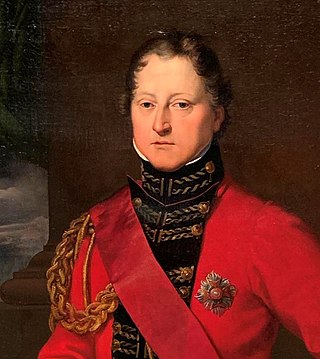
General Sir Gordon Drummond, GCB was a Canadian-born British Army officer and the first official to command the military and the civil government of Canada. As Lieutenant Governor of Upper Canada, Drummond distinguished himself on the Niagara front in the War of 1812 and later became Governor-General and Administrator of Canada.

The Battle of Chippawa, also known as the Battle of Chippewa, was a victory for the United States Army in the War of 1812, during its invasion on July 5, 1814, of the British Empire's colony of Upper Canada along the Niagara River. This battle and the subsequent Battle of Lundy's Lane demonstrated that trained American troops could hold their own against British regulars. The battlefield is preserved as a National Historic Site of Canada.
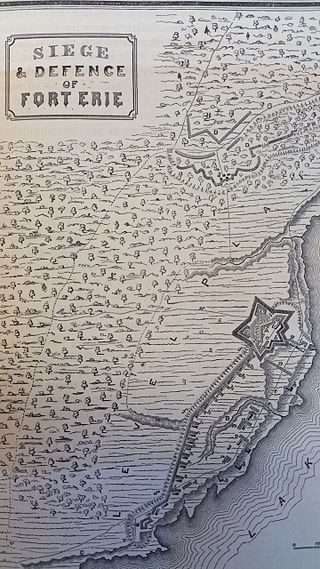

The Battle of Bladensburg was a battle of the Chesapeake Campaign during the War of 1812, fought on 24 August 1814, at Bladensburg, Maryland, 8.6 miles (13.8 km) northeast of Washington, D.C.
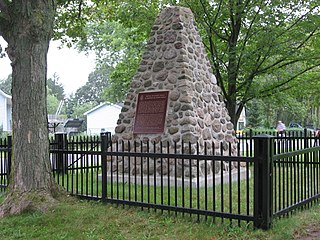

The Capture of Fort Niagara took place late in 1813, during the War of 1812 between the United Kingdom and the United States. The American garrison was taken by surprise, and the fort was captured in a night assault by a select force of British regular infantry.

General Sir Phineas Riall, KCH was the British general who succeeded John Vincent as commanding officer of the Niagara Peninsula in Upper Canada during the War of 1812. In 1816, he was appointed Governor of Grenada.
Benajah Mallory was a farmer, merchant and political figure in Upper Canada.
General John Vincent (1764–1848) was the British commanding officer of the Niagara Peninsula in Upper Canada when the United States attacked in the spring of 1813. He was defeated at the Battle of Fort George but was able to rebound and establish the new lines at Burlington Heights. He directed the campaign during the summer and fall that eventually forced the Americans to abandon the Niagara area in December 1813, thanks in large part due to his victory over the Americans at the Battle of Stoney Creek. Due to illness he was replaced by General Phineas Riall, though of the several officers of the 49th Regiment who reached high command during the War of 1812, Vincent was the longest-serving of them. British and Canadian accounts of the War give the impression of a modest, well-liked and generous officer, who gave whatever help he could to other commanders. From 1814, he had held the sinecure post of Lieutenant-Governor of Dumbarton Castle.
Events from the year 1814 in the United Kingdom.
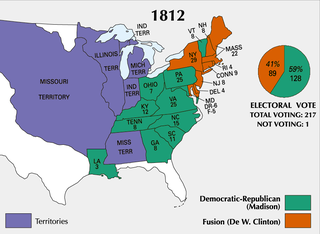
The following is a partial list of events from the year 1812 in the United States. After years of increasing tensions, the United States declares war on the British Empire, starting the War of 1812.
Events from the year 1813 in the United States.

The Battle of Buffalo took place during the War of 1812 on December 30, 1813, in the State of New York, near the Niagara River. The British forces drove off the American defenders and destroyed many buildings and ships. The operation was retaliation for American troops burning the Canadian village of Newark.
John B. Campbell was an American soldier during the War of 1812, famous for his expedition to destroy the Miami Indian villages along the Mississinewa River and perhaps most infamous for ordering the destruction of private houses and other property in Dover, Canada, including the stocks of grain and mills, which led to a Court of Enquiry and an unprecedented letter to the enemy explaining himself. He was mortally wounded at the Battle of Chippawa in July.
The Canadian Volunteers was a unit composed of pro-United States citizens or inhabitants of Upper Canada which fought for the United States of America during the Anglo-American War of 1812.